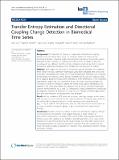| dc.contributor.author | Nemati, Shamim | |
| dc.contributor.author | Silva, Ikaro | |
| dc.contributor.author | Edwards, Bradley A. | |
| dc.contributor.author | Butler, James P. | |
| dc.contributor.author | Malhotra, Atul | |
| dc.contributor.author | Lee, Joonwu | |
| dc.date.accessioned | 2012-11-20T16:10:33Z | |
| dc.date.available | 2012-11-20T16:10:33Z | |
| dc.date.issued | 2012-04 | |
| dc.date.submitted | 2011-11 | |
| dc.identifier.issn | 1475-925X | |
| dc.identifier.uri | http://hdl.handle.net/1721.1/75000 | |
| dc.description.abstract | Background: The detection of change in magnitude of directional coupling
between two non-linear time series is a common subject of interest in the
biomedical domain, including studies involving the respiratory chemoreflex system.
Although transfer entropy is a useful tool in this avenue, no study to date has
investigated how different transfer entropy estimation methods perform in typical
biomedical applications featuring small sample size and presence of outliers.
Methods: With respect to detection of increased coupling strength, we compared
three transfer entropy estimation techniques using both simulated time series and
respiratory recordings from lambs. The following estimation methods were analyzed:
fixed-binning with ranking, kernel density estimation (KDE), and the Darbellay-Vajda
(D-V) adaptive partitioning algorithm extended to three dimensions. In the simulated
experiment, sample size was varied from 50 to 200, while coupling strength was
increased. In order to introduce outliers, the heavy-tailed Laplace distribution was
utilized. In the lamb experiment, the objective was to detect increased respiratoryrelated chemosensitivity to O[subscript 2] and CO[subscript 2] induced by a drug, domperidone. Specifically, the separate influence of end-tidal PO[subscript 2] and PCO[subscript 2] on minute ventilation ([dot over V][subscript E]) before and after administration of domperidone was analyzed.
Results: In the simulation, KDE detected increased coupling strength at the lowest
SNR among the three methods. In the lamb experiment, D-V partitioning resulted in
the statistically strongest increase in transfer entropy post-domperidone for
PO2 → [dot over V][subscript E]. In addition, D-V partitioning was the only method that could detect an increase in transfer entropy for PCO[subscript 2] → [dot over V][subscript E], in agreement with experimental findings.
Conclusions: Transfer entropy is capable of detecting directional coupling changes
in non-linear biomedical time series analysis featuring a small number of
observations and presence of outliers. The results of this study suggest that fixed-binning, even with ranking, is too primitive, and although there is no clear winner
between KDE and D-V partitioning, the reader should note that KDE requires more
computational time and extensive parameter selection than D-V partitioning. We
hope this study provides a guideline for selection of an appropriate transfer entropy
estimation method. | en_US |
| dc.description.sponsorship | National Institutes of Health (U.S.) (Grant R01-EB001659) | en_US |
| dc.description.sponsorship | National Institutes of Health (U.S.) (Grant R01- HL73146) | en_US |
| dc.description.sponsorship | National Institutes of Health (U.S.) (Grant HL085188-01A2) | en_US |
| dc.description.sponsorship | National Institutes of Health (U.S.) (Grant HL090897-01A2) | en_US |
| dc.description.sponsorship | National Institutes of Health (U.S.) (Grant K24 HL093218-01A1) | en_US |
| dc.description.sponsorship | National Institutes of Health (U.S.) (Cooperative Agreement U01-EB-008577) | en_US |
| dc.description.sponsorship | National Institutes of Health (U.S.) (Training Grant T32-HL07901)) | en_US |
| dc.description.sponsorship | American Heart Association (Grant 0840159N) | en_US |
| dc.language.iso | en_US | |
| dc.publisher | Biomed Central Ltd. | en_US |
| dc.relation.isversionof | http://dx.doi.org/10.1186/1475-925x-11-19 | en_US |
| dc.rights | Creative Commons Attribution | en_US |
| dc.rights.uri | http://creativecommons.org/licenses/by/2.0 | en_US |
| dc.source | BioMed Central | en_US |
| dc.title | Transfer Entropy Estimation and Directional Coupling Change Detection in Biomedical Time Series | en_US |
| dc.type | Article | en_US |
| dc.identifier.citation | Lee, Joon et al. “Transfer Entropy Estimation and Directional Coupling Change Detection in Biomedical Time Series.” BioMedical Engineering OnLine 11.1 (2012): 19. © 2012 BioMed Central Ltd | en_US |
| dc.contributor.department | Massachusetts Institute of Technology. Institute for Medical Engineering & Science | en_US |
| dc.contributor.department | Harvard University--MIT Division of Health Sciences and Technology | en_US |
| dc.contributor.department | Massachusetts Institute of Technology. Department of Electrical Engineering and Computer Science | en_US |
| dc.contributor.mitauthor | Lee, Joon | |
| dc.contributor.mitauthor | Nemati, Shamim | |
| dc.contributor.mitauthor | Silva, Ikaro | |
| dc.relation.journal | BioMedical Engineering OnLine | en_US |
| dc.eprint.version | Final published version | en_US |
| dc.type.uri | http://purl.org/eprint/type/JournalArticle | en_US |
| eprint.status | http://purl.org/eprint/status/PeerReviewed | en_US |
| dspace.orderedauthors | Lee, Joon; Nemati, Shamim; Silva, Ikaro; Edwards, Bradley A; Butler, James P; Malhotra, Atul | en |
| dc.identifier.orcid | https://orcid.org/0000-0001-8593-9321 | |
| dc.identifier.orcid | https://orcid.org/0000-0001-8464-5866 | |
| mit.license | PUBLISHER_CC | en_US |
| mit.metadata.status | Complete | |
